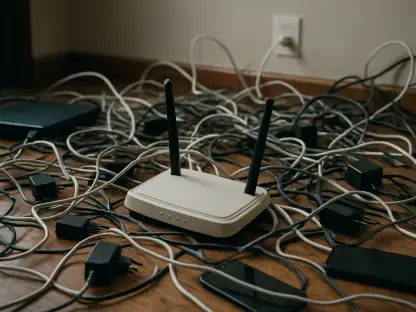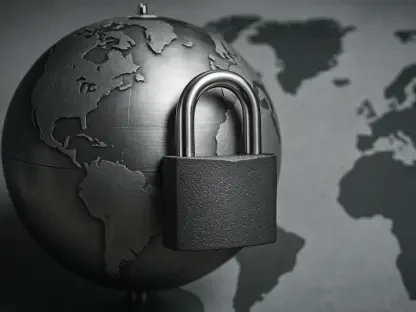In the world of expanding technologies, Matilda Bailey, a networking specialist, stands at the forefront of cutting-edge cellular and wireless innovations. Her expertise sheds light on emerging trends and next-generation solutions. Today, she delves into the fascinating intersection of chaos theory and encryption, particularly its application to IoT and IIoT devices. With a backdrop of increasing demand for secure communications in resource-constrained environments, Matilda provides a deep dive into how chaos theory might revolutionize traditional encryption methods.
Can you explain how chaos theory can be applied to encryption systems for IoT devices?
Certainly. Chaos theory, known for its sensitivity to initial conditions, offers a unique approach to encryption by creating unpredictable yet bounded outputs. In the context of IoT devices, the chaotic behavior can generate encrypted signals from sensor data, creating a seemingly random output that is difficult for unauthorized parties to decipher. This method harnesses chaos’s inherent unpredictability to enhance security, particularly suitable for the limited computational resources available on IoT devices.
Why is there a pressing need to develop secure encryption methods specifically for IoT and IIoT devices?
The pressing need stems from the nature of data transmitted by IoT devices, which often includes highly sensitive personal or operational information. As these devices become widespread, particularly in healthcare and industrial environments, ensuring secure communication is crucial to protect against data breaches and cyber threats. Current encryption methods face challenges due to IoT devices’ limited processing capabilities, prompting the exploration of alternative solutions like chaos theory.
What challenges do traditional and quantum encryption methods face when applied to IoT devices?
Traditional encryption methods often require significant computational power and can become vulnerable in the face of future quantum computing advancements. Quantum encryption demands even greater resources, which IoT devices typically lack. These limitations necessitate finding lightweight yet robust encryption techniques that can operate effectively within the constrained environment of IoT devices.
How does chaos theory offer a potential solution to these challenges?
Chaos theory offers a potential solution by enabling encryption that is both lightweight and secure. Its ability to generate unpredictable sequences within defined constraints allows for effective encryption without the need for extensive computational resources. The chaotic nature provides a robust security layer that can resist attempts at decryption or reverse engineering, making it particularly advantageous for IoT applications.
Could you elaborate on the concept of chaos synchronization and how it relates to encryption?
Chaos synchronization involves aligning two chaotic systems so they produce coordinated behavior under specific conditions. In encryption, this concept is indispensable as it allows for the reception and decryption of chaotic signals. When sender and receiver systems are perfectly synchronized, they can decode the encrypted chaotic noise back into the original data, enabling secure communication without traditional key exchanges.
What is Chua’s circuit, and why did you choose it as the starting point for your research?
Chua’s circuit is a pioneering electronic circuit known for its ability to exhibit chaotic behavior. Its simplicity and predictability within chaos make it an ideal model for studying chaos-based encryption. Choosing Chua’s circuit as the foundation allows us to explore chaotic phenomena systematically, offering potential insights to apply chaos theory in practical encryption systems for IoT devices.
How does your chaos encryption system process data from IoT sensors?
Our system processes data by directly feeding sensor inputs into the encryption engine, where it undergoes transformation into chaotic output. This chaotic signal becomes the encrypted data—essentially ‘data in, noise out’. As the process occurs entirely at the hardware level, it provides robust protection against data interception between sensor and encryption.
What are the main advantages of using chaos theory for encryption compared to traditional methods?
Chaos theory’s main advantages in encryption lie in its ability to provide strong security with minimal computational overhead. It produces outputs that appear random, offering high resistance to cryptographic attacks. Without the need for key exchanges, which add complexity to traditional methods, chaos encryption can streamline secure communication for resource-constrained devices.
Can you describe the security features inherent in chaos encryption?
Chaos encryption boasts several unique security features. First, it encrypts data right at the source, minimizing risks of interception. Second, the encrypted signal resembles random noise, which makes it difficult for attackers to detect or interpret. Finally, the impossibility of reverse engineering the chaotic output to deduce original parameters adds a layer of protection.
How does the decryption process work when using chaos synchronization?
In chaos synchronization, decryption requires the receiving system to mirror the sender’s conditions precisely. When both systems are synchronized, the encrypted chaotic signal is run through the same parameters, transforming it back into the original data. This synchronization ensures secure decryption without needing an actual decryption key.
Why can’t chaos encryption be mathematically verified like traditional methods?
Chaos encryption relies on natural laws rather than purely mathematical formulas. While traditional encryption depends on verifiable mathematical structures, chaos encryption derives its security from dynamic behaviors and synchronization properties. This reliance on natural principles makes it challenging to mathematically verify, similar to how quantum mechanics operates.
What were the initial steps in developing your chaos encryption system at AMD?
The development began with implementing Chua’s circuit onto digital platforms to examine its chaotic properties. Through simulation and analysis, the behavior of chaos was observed to tailor it for encryption purposes. These findings led to creating the discrete-time encryption engine, ultimately achieving a proof of concept demonstrating chaos encryption’s feasibility.
Could you share details about the proof of concept you achieved for chaos encryption?
The proof of concept involved implementing chaos encryption on 45 nm CMOS ASIC platforms, showing its potential for integration into hardware. This demonstration validated the capability of chaos theory to function within the constraints of IoT devices, affirming ultra-low power consumption and minimal silicon area requirements—key factors for resource-constrained environments.
What are the main technical advancements your research brought to integrating chaos encryption into hardware?
Our research led to significant advancements in hardware efficiency for chaos encryption. By using discrete-time models, we achieved minimal power consumption and silicon area usage. This paves the way for integrating chaos-based encryption systems into small-scale devices while maintaining high-security standards.
Where does your research currently stand in terms of potential production?
Currently, the research has reached a stage where we have a robust proof of concept that is ready for optimization. We need to upgrade to newer silicon processes around 10 nm or 14 nm before aiming for full-scale production. It’s a crucial step to align with current technological capabilities and market demands.
What steps are needed to advance from proof of concept to full-scale production?
To transition to full-scale production, we must refine the chaos engine’s design and adapt it to modern silicon technologies for enhanced efficiency. Collaborating with industry partners to implement and test these optimizations is essential. Additionally, addressing any scalability challenges will ensure successful integration into IoT platforms.
How does your work on chaos encryption relate to current cybersecurity concerns, such as the threat of quantum computing to traditional encryption?
Chaos encryption offers a quantum-resistant alternative, capable of safeguarding data in the imminent quantum era. Its reliance on chaotic dynamics makes it less susceptible to quantum decryption methods. As quantum computing poses a significant threat to traditional encryption, chaos encryption becomes increasingly relevant for securing IoT devices.
What are the next milestones you aim to achieve in your research on chaos encryption?
The next milestones include optimizing chaos encryption systems for production readiness and further integrating them into diverse IoT environments. We aim to enhance synchronization reliability between devices and explore broader applications of chaos theory in cybersecurity. Advancing our research to align with industry needs is key to fostering widespread adoption.









